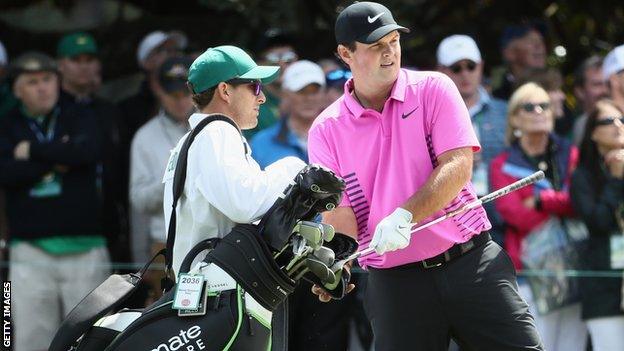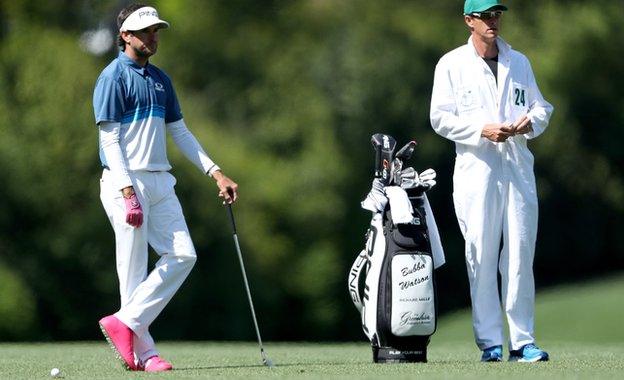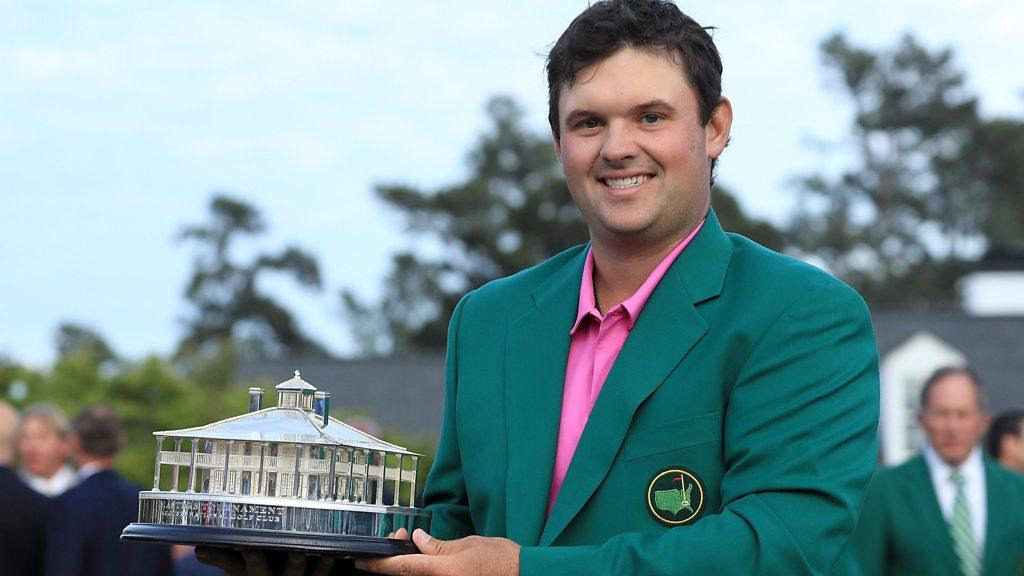Masters 2018: Patrick Reed's equipment gamble paid off at Augusta
- Published
- comments
Masters 2018: 'New kid on the block' Reed wins 2018 Masters
Amid all the talk of estrangement in the wake of Patrick Reed's Masters victory there emerged another tale of separation to fascinate followers of professional golf.
While discussion of Reed's troubled family background dominated the post-Augusta headlines, another nugget surfaced when he did the US talk show rounds clad in his new green jacket.
The 27-year-old, whose gutsy triumph yielded his first major title, revealed his greatest win had been achieved with a handpicked set of clubs.
Unlike the vast majority of his leading rivals, Reed played with a mixed collection rather than a uniform set prescribed by a lucrative deal with a leading manufacturer.
"The biggest thing was I wanted to be different," Reed told the business network CNBC, external when asked about leaving his club deal at the end of last season.
"It's hard to believe there is one company that makes 14 perfect golf clubs and a perfect golf ball for every player."
There are not many leading pros who would publicly say such a thing.
Taken at face value, this suggests the most unusual aspect surrounding Reed is not the fact he does not talk to his parents, but that he is a professional golfer prepared to eschew huge riches from an all-encompassing equipment contract.

Reed's caddie Kessler Karain carries a carefully selected bag of clubs for his man
For his Masters breakthrough the American had Ping, Titleist and Callaway gear in his bag as well as Artisan wedges. It was a bespoke assembly aimed at maximising his comfort around Augusta National.
"This has freed me up," Reed added. "On the equipment side, I'm just out there doing my thing. I'm using whatever I want to use.
"I'm able to put 14 golf clubs and a golf ball in the bag that I feel are the perfect fit for me. To do that and come out with my first major, it was a risk. But it was a risk that was the right one."
It is a refreshing approach, a break from the commercial normality of the professional game. For fans, it is surely more authentic to know a player is using a certain club or ball because they like it rather than for vast financial gain.
The elite players receive millions to play exclusively with the clubs and balls of a certain manufacturer and to then tell us they are competing with the best equipment they have ever used.
Others may have deals where the majority of their bag is from one firm and they supplement it with drivers or putters of their choice. It is not unknown for the headcover of the sponsoring manufacturer being disingenuously used to conceal a driver from a rival company.
At every level, commercial interests permeate the paid ranks. It is an inevitability, of course, but players become clothes horses for the biggest sponsors and sporting apparel enterprises.
And while this set up provides financial security, it also erodes individuality and character.
How do you spot a pro golfer in the street? Chances are an incongruously pale forehead provides the giveaway clue.
No matter how wealthy they become, it seems every player is ready to cash in on cap deals that lead largely to uniformity, anonymity and a two-tone head.
This is despite many preferring to play without headgear when they have the choice. They are not obliged to wear any kind of hat at the Ryder Cup and many choose to go without.
With obligatory peaked caps largely absent in the biennial matches between Europe and America, we get a much better idea of their characters. Although they are wearing a team uniform, their individuality is much more apparent.

Bubba Watson is easy to spot on the course in his neon pink high-top shoes
Close your eyes and think of some of the great characters of golf - Seve Ballesteros, Jack Nicklaus, Sir Nick Faldo and Greg Norman. I'd wager the images you carry of these titans does not involve them wearing headgear.
Even those who did don a hat in days gone by, did so with a sense of individuality - Ben Hogan's flat cap being a prime example.
Nowadays the players reject such choices. Robert Rock seems to be the last European Tour star unencumbered by headgear after Tyrrell Hatton lived up to his name by putting one on to spread the commercial word while swelling his bank balance.
Other exceptions would include the unorthodox Bryson DeChambeau, who borrows from Hogan's sartorial playbook and Rickie Fowler, who dons a wide-brimmed cap to separate himself from the rest.
Throw in Bubba Watson's pink 'high-tops' to match the vibrant colour of his driver and you have more or less covered the full gamut of golfing individuality.
It is largely parked for financial gain and Reed is ironically actually a prime example. He was required to ditch his usual red and black final-round outfit for the Masters at the behest of his clothing sponsor.
They did not want it to clash with the traditional Sunday attire of Tiger Woods, their number one star.
Nevertheless, Reed ultimately proved pretty in azalea pink. And the smiling eyes beneath his distinctively white forehead told a story of how the policy of using his own tools, if not clothes, worked out so well at Augusta.
It gave him the green garment every male golfer would choose to win.
- Published9 April 2018

- Published1 April 2018
